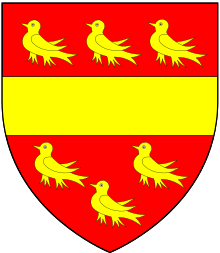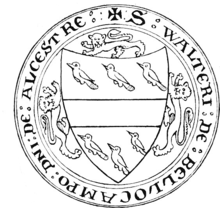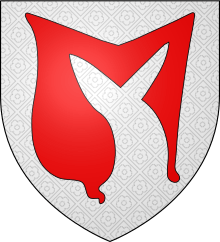Walter de Beauchamp (Steward to Edward I)
Walter de Beauchamp (died 1303/6),[1] (Latinised to de Bello Campo) of Beauchamp's Court, Alcester[2] in Warwickshire and of Beauchamp Court, Powick in Worcestershire,[3] was Steward of the Household to King Edward I[4] from 1289–1303.[5] He was the younger brother of William de Beauchamp, 9th Earl of Warwick (c.1238-1298), the first of his family to hold that title (inherited from their mother) and was the founder of the junior line of the Beauchamp family known as "Beauchamp of Powick".


Origins
He was a younger son of William III de Beauchamp (c.1215-1269) of Elmley Castle in Worcestershire, hereditary Sheriff of Worcestershire, by his wife Isabel de Mauduit, daughter of William de Mauduit of Hanslope in Buckinghamshire and Hartley Mauditt, Hampshire (by his wife Alice de Beaumont (d. pre- 1263), half-sister of Henry de Beaumont, 5th Earl of Warwick[6] (c.1192-1229)) and sister and heiress of William Mauduit, 8th Earl of Warwick). His eldest brother was William de Beauchamp, 9th Earl of Warwick (c.1238-1298).
Career
By 1268 he had been "signed with the cross"[3] for a pilgrimage to the Holy Land, in which year his father signed his will mentioning Walter as being a crusader to whom he bequeaths 200 marks "for his better performance of that voyage".[7] He was at the Battle of Falkirk in 1298 and at the Siege of Caerlaverock Castle in Scotland in 1300, with the king. He signed and sealed the Barons' Letter of 1301 to the pope as Walt(er)us de Bello Campo, D(omi)n(u)s de Alcestre ("Walter de Beauchamp, Lord of Alcester"). Another of the signatories was his nephew Guy de Beauchamp, 10th Earl of Warwick (c.1272-1315).
Caerlaverock Roll
At the Siege of Caerlaverock Castle in Scotland in 1300 the heralds blazoned the arms of all the English knights present in Norman-French verse, known as the Caerlaverock Roll. The part regarding "Wautier de Beauchamp" is as follows:[8][9]
Puis i out Wautier de Beauchamp
Sis merlos de or el rouge champ
O une fesse en lieu de dance
Chevalier selon ma cuidance
Un des mellours fut entre touz
Se il ne fuit trop fiers et estouz
Mes vous ne orrez parler james
De senescal ke ne ait une mes.<ref>In modern French: Puis Gautier de Beauchamp avait six merlettes d'or sur un champ rouge à une fasce au lieu d'une dance. Chevalier, selon mon avis, un des meilleurs qui fut entre tous, s'il n'était trop fier et trop audacieux; mais vous n'entendrez jamais parler du sénéchal sans un «mais».</ref>
Which may be translated as:[10][11]
- "Then there was Walter de Beauchamp, having six martlets of gold with a red field with a fess instead of dancetée[12] (standard blazon: Gules, a fess between six martlets or). He was in my opinion one of the best knights of the whole if he had not been too proud and violent, but you won't hear anyone talk of the steward without a 'but'".
Inherits Powick
At his father's death in 1269 Walter inherited his family's part of the manor of Powick in Worcestershire, where he made his seat at Beauchamp Court, on the right bank of the River Severn. The estate had been inherited, together with Elmley Castle and other lands, by Walter's three-times great-grandfather Walter I de Beauchamp (d.1130/3), founder of the Beauchamp family, on his marriage to Emmeline d'Abitot, daughter and heiress of Urse d'Abitot, Sheriff of Worcestershire.[13] In 1300 he received a royal grant of free warren in his demesne lands of Powick and at some time established a chantry "in the court of his manor" at Powick.[14] The family he founded is generally referred to as "Beauchamp of Powick" to distinguish it from the other branches, namely the senior branch of Earls of Warwick "Beauchamp of Elmley" and another branch "Beauchamp of Holt". The martlet arms he adopted ("Beauchamp of Powick") as a difference to his paternal arms were also borne by his descendants.
Acquires Alcester
In about 1263 he acquired a moiety of the manor of Alcester in Warwickshire which he held from Reynold FitzPeter by the tenure of "doing the foreign service of ½ knight's fee". In about 1274 he confirmed to his free burgesses and tenants their ancient right to hold a weekly market on a Tuesday, and also granted them a weekly market on a Thursday, allowing the sale of animals, flesh, wheat, rye, barley, oats, beans, pease, woollen and linen drapery, bread, iron goods, tallow, grease, fish, leather goods, baskets, hides, wool, linen, geese, hens, cheese, bacon, eggs, salt and spices.[15] In 1291 he received royal licence to cultivate 60 acres of his wood in Alcester within the forest of Feckenham and in 1300 he was granted by the king free warren in his demesne lands of Alcester. In 1292 he obtained a royal grant for an annual fair "on the eve, day and morrow of St. Giles and for five days following".[15] The other moiety of the manor was eventually acquired (from Thomas Botreaux) in 1444 by his descendant John Beauchamp, 1st Baron Beauchamp (d. 1475) "of Powick"[15] in Worcestershire.[4]
Marriage and children

He married Alice de Tosny,[16] a daughter of Roger V de Tosny of Flamstead in Hertfordshire by his wife Alice de Bohun, a daughter of Humphrey IV de Bohun, 2nd Earl of Hereford, 1st Earl of Essex (1204-1275), Hereritary Constable of England.[17] Unbeknownst to themselves they were found to be within the fourth degree of consanguinity, which necessitated a ratification of the marriage by Godfrey Giffard, Bishop of Worcester to legitimise their issue.[18] By his wife he had issue including:
- Walter de Beauchamp (d.1328), of Alcester,[19] eldest son and heir. In 1307 he was fighting the Scots and in 1317 he became the guardian of Warwick Castle and its lands following the death of his nephew Guy de Beauchamp, 10th Earl of Warwick (c. 1272 – 1315) who left an infant son Thomas de Beauchamp, 11th Earl of Warwick (c.1313-1369).[3]
- William de Beauchamp, "a military man of celebrity"[3] who inherited some of his elder brother's lands. In 1320 he was appointed by King Edward II as Governor of St Briavel's Castle in the Forest of Dean, Gloucestershire.[3] He married a certain Joan with whom in 1334 he settled the manors of Powick and Bransford on themselves and their heirs,[19] but he died childless.
- Giles de Beauchamp (d.1361),[19] heir of his eldest brother, who in 1340 received royal licence to crenellate (to fortify with a wall of stone and lime[3] and embattle) his manor house at Alcester, and a similar licence two years later for his house at Freshwater, Isle of Wight.[3] He married Katherine de Bures.[17] His son and heir was Sir John de Beauchamp, who in 1386 was keeper of Gloucester Castle.[19] Giles's great-grandson was John Beauchamp, 1st Baron Beauchamp (d. 1475) "of Powick"[15] in Worcestershire.[4]
Further reading
- Douglas Richardson, Magna Carta Ancestry: A Study in Colonial and Medieval Families, 4 vols, ed. Kimball G. Everingham, 2nd edition, volume III, Salt Lake City, 2011, pp. 384–5, "Powick"; vol I, p. 223 "Boddington"
References
- Burke 1306; VCH 1303
- 'Parishes: Alcester', in A History of the County of Warwick: Volume 3, Barlichway Hundred, ed. Philip Styles (London, 1945), pp. 8-22
- Burke
- http://www.histparl.ac.uk/volume/1386-1421/member/beauchamp-sir-william-1421
- Edward I By Michael Prestwich, pp.145-6
- GEC Complete Peerage, Vol.XII, p.367
- Burke; VCH: "mentioned in his father's will in 1268 as a Crusader"
- Caerlaverock Roll, K-045
- Edward Jeffery, ed., The Antiquarian Repertory: A Miscellaneous Assemblage, Volume 4, 1808, p.479
- Jeffery
- Prestwich, p.146
- Contrasting it with the previous verse referring to John de Engaigne whose arms were blazoned as Gules, a dancetée and crosslets or
- Victoria County History, 'Parishes: Powick', in A History of the County of Worcester: Volume 4, ed. William Page and J W Willis-Bund (London, 1924), pp. 184-192 ; "In 1269 3 carucates of land in Powick and Bransford were settled on Walter and his wife Alice de Toeni", VCH quoting "Feet of Fines. Worcs. 54 Hen. III, no. 29; Duchy of Lanc. Anct. D. L 1447"
- Victoria County History
- VCH Worcestershire, re Alcester
- alias de Tosny/Toni, etc., surname per Victoria County History
- Richardson
- John Burke, General and Heraldic Dictionary of the Peerages of England, Ireland, and Scotland, extinct, Dormant and in Abeyance, 3rd ed., London, 1846, pp.37-8
- Victoria County History, Powick